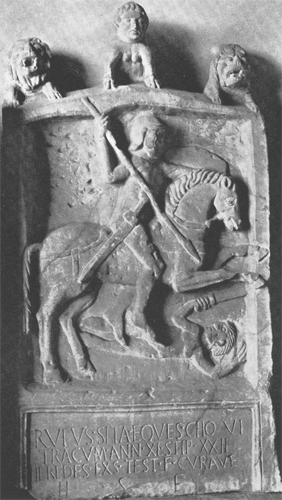
This page created 14 November 2015, and last modified: 9 December 2015 (RIB II reference modified)

The second officer listed (154.18 in Ingo Maier's numbering scheme) under the command of the Dux Britanniarum following the subsection headed "along the line of the Wall" (item 154.16, per lineam valli), is the Tribunus cohortis primae Cornoviorum, said to be stationed at Ponte Aeli.
The men under the Tribunus cohortis primae Cornoviorum are unique among the units serving in Britian in having a name that is ethically British: that of the Cornovii. Although there may have been several groups of Cornovii in Britian, the most important one, and the almost certainly to be involved here, was located in the Chester-Wroxeter region. Many unit of British origin are attested serving in the Roman army, whether in the Notitia or in other sources, but they all served outside Britain. That the unit is unattested outside might be seen as an indication it was a late addition to the British garrison, but since it is listed as being a cohors, this gives me cause to doubt this hypothesis: a late-3rd or a 4th-century addition would likely be styled as a numerus.
 Rufus Sita of cohors VI Thracum displaying the traditional riding-down-a-barbrian-footman iconography of Principate-era Roman cavalrymen's tombstones. Photo from the Gloucester City Museum, and used with kind permission. |
Instead, I would suggest the unit may have been known originally by some other name, and later took the name Cornovii because it was stationed at the main city of the Cornovii at one point: Viroconium Cornoviorum (modern Wroxeter). The city is known to have had a garrison only in the 1st century (Legio XIIII), but a tombstone (RIB 291) of a trooper from a (part-mounted) COH [.] THRACUM may be evidence for a further unit being stationed at the place at some point. This can't be cohors VII Thracum, as there isn't enough space for "VII" to fit into the missing part of the tombstone, and it is unlikely to be cohors II Thracum, as this is well-attested, except for a period in the second century when it was in Scotland (RIB 2142), as being at Gabrosentum, modern Moresby, not only epigraphically, but also in the Notitia (154.33).
It might possibly be cohors I Thracum, which has the advantage of having the same unit number, "I" as that of the Cornovii, but this unit is strongly associated with Bowes (Roman Lavatris), so might not have had the chance to be associated with Wroxeter. The only other candidate is cohors VI Thracum, a unit that has only two British epigraphic records: lead sealing stamps (RIB 2411.152-60) from Brough-under-Stainmore (Roman Verteris), and a tombstone (RIB 121, see left) from Gloucester (Roman Glevum), showing a cavalryman with a somewhat hexagonal shield; the face of the shield is alas not shown, so no shield pattern is visible. This unit has the advantage of Rufus Sita's tombstone being relatively near Wroxeter; however, I think the balance of probabilities lies with cohors I Thracum, as imagining it being known colloquially as cohors I Thracum Cornoviorum is easy; whereas a transition from cohors VI Thracum to cohors I Cornoviorum would require a renumbering as well as a renaming. No matter which unit may putatively have become cohors I Cornoviorum, there is a possibility the unit may have left Britain, possibly after the Notitia's original compilation, possibly before, but in either case, before its last amendment. This possibility arises from the unit's station: Ponte Aeli (i.e. Pons Aeli; modern Newcastle-upon-Tyne). The place was named after the bridge there over the Tyne, apparently the only one outside of Rome bearing an imperial name: emperor Hadrian's name was Publius Aelius Hadrianus. The last unit listed (102/5.90) in the Magister Peditum's Italian command is a a pseodocomitatenses called the Pontinenses, who seem to have taken their name from their last station before joining the field army. And while it is true there are many locations that can be identified with bridges in the empire, only the British location would seem to have evidence for troops being withdrawn from its around the time of the Notitia's compilation. |
As with all limitanei units in the Notitia, the shield pattern of the Cohors IV Lingonum is not illustrated. That of the Pontinenses is however:

However, even if the Pontinenses = cohors I Cornoviorum equation is accepted, it by no means follows the pattern of the unit was as shown above while it served in Britain, as there are many indications in the Notitia that limitanei units that were given pseudocomitatenses status received new shield patterns.
1. Ingo Maier; "Appendix 4: Numeration of the new edition of the compilation 'notitia dignitatum' (Cnd)"; last accessed 26 October 2015. See also for here for numbering examples. Return
2. S.S. Frere, Margaret Roxan, & R.S.O. Tomlin (Eds); "The Roman Inscriptions of Britain", Vol. II, Fasc. I; Allan Sutton, Gloucester, 1990. Return

Return to the Notitia alphabetical unit list page.
Return to my Notitia index page.